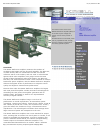
03/13/2007 05:35 PMKrell Audio Components MRA
Page 2 of 3http://www.krellonline.com/krell_component.php?id=30&page=MRA
removable/interchangeable plug-in module, called a software
key, can be individually programmed, allowing the Master
Reference Amplifier to be customized to match the impedance
curve of any given loudspeaker. In addition, this microprocessor-
controlled, fully active regulation enables the Master Reference
Amplifier to develop full power into the most demanding loads,
with no drop in current or voltage. Only the Master Reference
Amplifier has this feature, which continually monitors and adjusts
the power source to compensate for even the smallest variation
in current or voltage.
A new Krell technology contributes to the Master Reference
Amplifier's superiority and further enhances Master Reference
Amplifier performance when connected to appropriately equipped
Krell source components. CAST, Current Audio Signal
Transmission, has been developed to send audio signals from
component to component without introducing the negative
effects of interconnect cables into the signal, i.e., loss of gain,
reduced slew rate, and tonal coloration. Moreover, it reduces the
number of total gain stages in the system and unifies each
component in the system. CAST technology serves as a current
gain interface and preserves current gain circuitry throughout the
entire system. This has never been possible before CAST
technology because conventional audio components and
interconnect cables interface via voltage gain. The preamplifier
has high output impedance and delivers current, not voltage, to
the amplifier. The amplifierÂ’s input senses and amplifies this
current, which is not altered by interconnect cableÂ’s impedance
characteristics because the cable imped- ance and reactive
effects are reduced to at least a million times less than the total
system impedance. CAST ensures that interconnects cable
lengths and characteristics do not degrade the signal quality. As
a result, listeners can employ long cable runs and still maintain
signal integrity. This means listeners can place components
where they wish to place them. CAST technology also renders
obsolete the mysterious art of "matching" components and
interconnect cables to achieve certain desired sonic results. CAST
delivers accurate signal transmission without sonic coloration and
takes the "guesswork" out of installing a reference system.
The Master Reference Amplifier's ability to resolve detail,
recreate holographic imaging, convey impact, and preserve tonal
balance is unparalleled. The basic function of the Master
Reference Amplifier is to emulate a pure voltage and current
source and to provide a superabundant amount of accurate
power into any impedance load, ensuring maximum performance
from every speaker system. The core technologies applied in the
Master Reference Amplifier focus on this goal.
The Krell Current Mode gain stages within the Master Reference
Amplifier ensure high quality sound performance. These stages
operate in current mode, rather than voltage mode amplification.
This is accomplished by parallel operation of many small signal
transistors, which are selected specifically for their low self-noise,
wide bandwidth, and high linearity. Krell Current Mode operation
significantly boosts output drive capability. At the same time, the
low impedance intrinsic to Krell Current Mode operation
minimizes noise and preserves wide bandwidth operation.
Class A operation is by far the most desirable for performance,
but pure Class A can cause reliability problems along with
environmental and economic ones. The Master Reference
Amplifier employs Class A operation managed by Sustained
Plateau Bias II circuitry.





